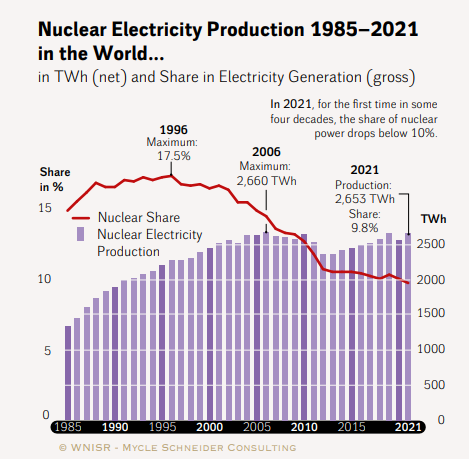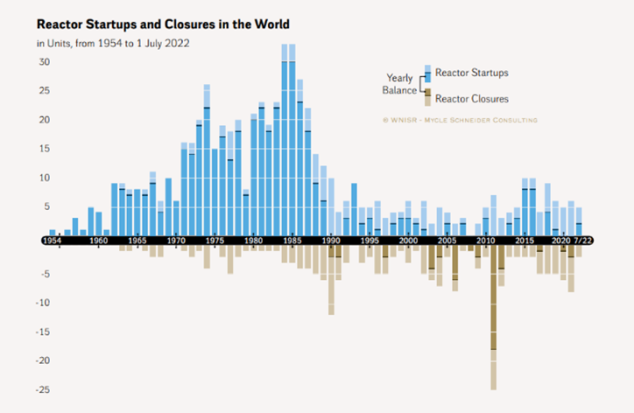Nuclear energy worldwide 2023
Worldwide, different paths are followed regarding the use of nuclear energy for electricity generation. Roughly, three groups can be distinguished: While some are striving to phase out nuclear energy, others are keeping their nuclear power plants (NPPs) running, while still others are expanding their nuclear energy structures or promoting the development of new reactor concepts.
Among other things, the following arguments are put forward: For example, supporters refer to the reliability with which electricity from nuclear energy is supplied or point to the comparatively low CO2 footprint during operation, which is seen as an advantage in the fight against climate change. Among the forms of electricity generation that do not emit CO2 during operation, nuclear energy ranks second according to data from the World Climate Report. Opponents cite, for example, the risk of accidents, the issue of radioactive waste disposal or the comparatively high financial cost and time needed for the construction of the plants. Due to the immense increase in energy costs, however, the question of the economic viability of nuclear energy use is being reassessed in many countries.
This dossier provides an overview of nuclear energy worldwide. It is updated once a year and republished on the GRS website.
Situation worldwide
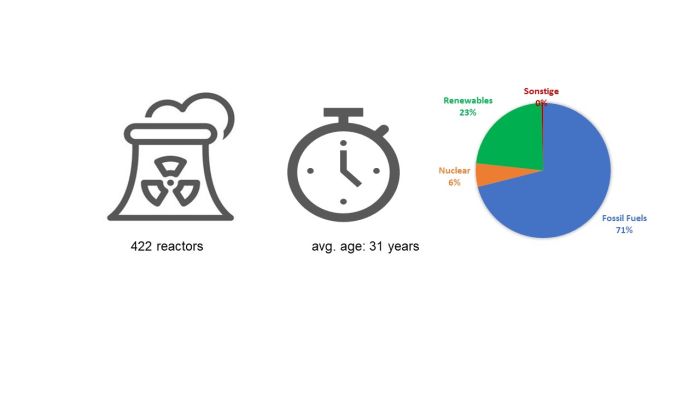
There are currently 422 nuclear reactors in operation worldwide with an average age of around 31 years, 57 units are currently under construction, and In recent years, the share of nuclear energy in global electricity production has been fairly stable at between 10 and 11%, which is quite far from its record high (17.5% in 1996). The figures relating to the electricity mix worldwide and for the respective continents were taken from the International Energy Agency (IEA) and reflect the status in 2019; the figures relating to the electricity mix of the individual countries were taken from the WNISR. 204 have been decommissioned or are currently being dismantled. The average age figures in this text are based on the date commercial power operation started and reflect the October 2022 status from the World Nuclear Industry Status Report (WNISR); the number of reactor units here and the figures below were taken from the International Atomic Energy Agency (IAEA). The WNISR arrives at a somewhat lower number of operating reactors. This is because different definitions are used here as to which reactors are running in “suspended operation” mode. These are reactors shut down for the long term but not finally decommissioned yet. The majority of these reactors are located in Japan. These “long-term outage reactors” were still counted as operating reactors by the IAEA last year. This also explains the discrepancy with the number of operating reactors in last year's text Nuclear energy worldwide 2022.
In recent years, the share of nuclear energy in global electricity production has been fairly stable at between 10 and 11% but last year it fell below the 10% mark for the first time in 40 years and is quite far from its record high (17.5% in 1996).
The figures in this text relating to the electricity mix worldwide and for the respective continents were taken from the International Energy Agency (IEA) and reflect the status in 2020. The figures relating to the electricity mix of the individual countries were taken from the WNISR.
The percentage decline is not due to less electricity being produced in NPPs. It is rather due to the fact that the relative share has fallen because renewable energy generation facilities have been expanded, but above all because fossil-fuel power plants based on coal, oil and gas produce significantly more electricity in absolute terms than in previous years and decades.
Looking at the constantly changing global reactor landscape, the following trends can be identified: Most new reactor units are being built in Asia, whereas most of the reactors being dismantled are sited in Western Europe and North America. Accordingly, the average age of reactors in Asia is comparatively low. New reactor units also have a greater average output than those that have been decommissioned so that despite a decline in the number of reactor units, the installed capacity can increase. The so-called small modular reactors (SMRs) are an exception: The "NPPs in mini format" are expected to play an important role in the medium-term planning of low-CO2 and decentralised electricity production in some countries.
After a brief summary, a few countries are presented for each continent that either operate a particularly large number of reactors or where new developments have taken place or are emerging. For a more detailed list of all countries, please refer to the IAEA's Power Reactor Information System (PRIS) or the World Nuclear Industry Status Report.
For a more detailed list of all countries, please refer to the IAEA's Power Reactor Information System (PRIS) and the World Nuclear Industry Status Report.
Note: Unlike in the previous year, the Russian Federation, together with the Central Asian republics, Azerbaijan and Georgia, falls under the new Eurasia heading at the IEA. The figures for the European electricity mix therefore exclude the Russian values, which are instead included for Asia. As far as the number of reactors is concerned, the systematics of the IAEA is followed, according to which Russia counts as part of Europe.
Europe
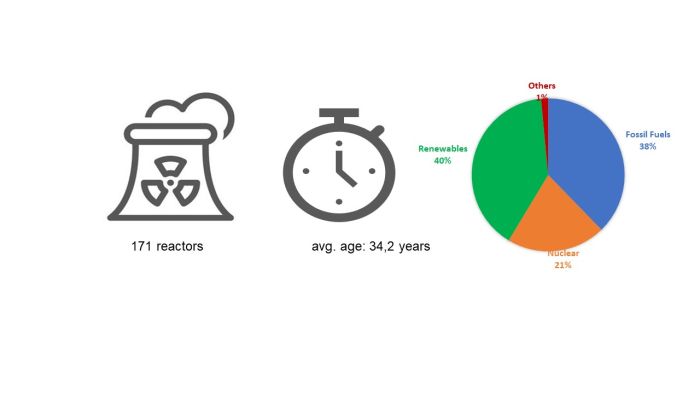
In Europe, nuclear energy accounted for approximately 21% of the total electricity production in 2020. A total of 173 reactors are in operation in Europe, with an average age of 34.2 years. 16 reactors are currently under construction, 124 are being dismantled.
Germany
In Germany, three reactors have still been connected to the grid since the beginning of 2022: Emsland, Isar 2 and Neckarwestheim II; they are scheduled to continue producing electricity in stretch-out operation mode until 15 April 2023, when they will be finally shut down. The average age of the three reactors is 34.5 years. Together, the three NPPs produced 6.1% of the electricity for public power supply last year.
NPPs, however, are not the only nuclear facilities in Germany. For example, the six research reactors currently in operation are allowed to continue operation. The same applies to the so-called nuclear fuel cycle facilities. In addition to the storage and disposal facilities for radioactive waste, these include the fuel fabrication plant at Lingen and the uranium enrichment plant at Gronau.
Western Europe
Nuclear accounts for the largest share in the energy mix in France. In 2021, it was 69% but due to the various problems with the reactor fleet, the figure for 2022 will be lower. Moreover, with 56 reactors, France is also the European leader in this respect. However, the last reactor was connected to the grid already in 1999 and the average age is 37.3 years. A new unit is currently being built at the Flamanville NPP. The construction project began in 2007 and was originally scheduled for completion by 2012. However, the schedule was extended several times, and costs have multiplied since then: for example, fuel loading is currently scheduled for the first quarter of 2024; the costs recently rose from 12.7 to 13.2 billion euro (the original forecast was 3.3 billion euro).
Nevertheless, nuclear energy is to continue to play an important role in France's climate protection plans. At the presentation of the “France 2030” investment plan, Emanuel Macron described the promotion of nuclear energy as a primary objective. One billion euros are to be allocated for the development and commissioning of the Nuward small modular reactor (SMR) by 2030. At the same time, six next generation EPR2 reactors are to be built, and plans are also to be presented for eight other sites and reactors. Concrete plans for plants with an envisaged commissioning between 2035 and 2037 are to be presented this year. Macron also announced that reactor lifetimes will be extended to 50 years or more – provided that safe operation is ensured. In addition, France continues seeking to export its EPR technology.
The United Kingdom also continues to rely on nuclear energy – around 14.8% of the electricity produced there currently comes from NPPs. Nine reactor units are in operation, two more are under construction (Hinkley Point C) and 36 reactor units are being dismantled. At the Sizewell site, two EPR units are to be built. The British government has therefore decided to invest 700 million pounds in preparing the Sizewell C site. According to the Johnson government's “Ten Point Plan for a Green Industrial Revolution”, nuclear power is to play an important role in the energy mix in the future – explicitly including SMRs and advanced modular reactors (AMRs). Under the impression of the Russian war of aggression, the British government has further specified this goal, also with a view to ensuring independent, domestic energy production: a nuclear generation capacity of up to 24 GW is to be achieved by 2050. Here, it is to be taken into account that the eight AGR units (approx. 4.8 GW) will have to be shut down permanently by the end of this decade due to advanced ageing effects in the graphite moderator. Regarding the development of SMRs, the Rolls-Royce group, for example, has announced that it will sell reactors on a smaller scale (currently the manufacturer indicates an expected capacity of 500 MW) from the early 2030s, both in the Kingdom and abroad.
In addition, Belgium is particularly noteworthy, where seven reactors covered more than half of the country’s electricity demand. However, Doel 3 was shut down in September 2022, Tihange 2 will follow on 1 February 2023. Another three reactors are to be permanently shut down in 2025 after 50 years of operation each. The two youngest units however, Doel 4 and Tihange 3, are to continue operation until 2036, subject to a corresponding licence – a corresponding agreement between the Belgian government and the operator Engie Electrabel was concluded on 9 January 2023. Moreover, a return to nuclear energy is not ruled out: 100 million euro are planned to be invested in research and development work for SMRs.
In the neighbouring Netherlands, two new reactor units are to be built according to the new coalition agreement in addition to the one in Borssele; the government is providing 5 billion euro for this. The year 2035 is targeted for the commissioning of the new units. In view of the necessary investigations, the government assumes that a final decision on the siting cannot be made before the end of 2024. The operating life of the only NPP currently in operation is to be extended beyond the already extended period of 60 years.
All in all, no major expansion activities can be seen in Western Europe. Apart from France and the UK, only Finland will connect another unit (Olkiluoto 3) to the grid in the near future, in addition to the four units in operation. The reactor unit had been commissioned at the beginning of 2023, commercial operation is expected to start soon (beginning of March 2023) and will lower the average age of Finnish reactors to 35 years. The government has also announced that it will extend the lifetime of the VVER-440 units from 50 to 70 years. Against the background of the Ukraine war, the new construction project of a Russian VVER-1200 at the Hanhikivi site, which had already started, was discontinued.
All current new construction projects in Western Europe have in common that the originally calculated costs and construction times have massively increased.
Central and Eastern Europe
In 2021, the 15 reactors in Ukraine produced 55% of the total electricity. Despite the war situation and the associated safety risk factors, the country will probably stick to nuclear power as the most important form of electricity generation, at least in the medium term. Two more units are planned to be built at the Khmelnytskyi site. Corresponding agreements were signed with the US company Westinghouse, and the American AP-1000 technology is intended to be used for all four new units. A total of nine AP-1000 reactors are planned in Ukraine. Some of the operating life extensions have been approved for the reactors currently in operation.
In Slovakia, in addition to the four reactors currently in operation, which produce 52.3% of the total electricity, two more VVER-440s are scheduled to start commercial operation this year and next year, respectively.
The situation is similar in Hungary, where nearly half of its electricity is currently supplied by four reactor units. There are plans to build two VVER-1200 units at the Paks site; the construction licence for the first unit was granted last year and excavation work has begun.
A new reactor unit is also to be built in Bulgaria. A corresponding plan was approved by parliament in 2021. It is to complement the two VVER-1000 reactors at the Kozloduy site, which currently produce around one third of the total electricity.
In the Czech Republic, two units with 1000 MW at the Dukovany site have been put out to tender, and initial bids have already been received from EdF, Westinghouse and KHNP. At the Temelín site, the construction of SMRs is planned for the near future. Currently, six reactor units produce 36.6% of the Czech Republic's electricity.
Poland is planning to enter nuclear energy, the first reactor unit is expected to go into operation in 2033, five more are to follow by 2043. Contracts were concluded with American companies (Westinghouse and Bechtel) for a site on the Baltic Sea for the construction of three AP-1000s. At the same time, negotiations are underway with the Korean company KHNP for the construction of APR-1400 plants.
In Belarus, the first reactor unit has been in operation for two years, the second is scheduled to start commercial operation this year. In Turkey, an NPP with four Russian VVER-1200s is currently under construction. Commissioning is expected to take place between 2025 and 2028.
In Russia, 20% of the electricity mix is produced by 38 reactors, whose average age is 29.1 years. Over the last ten years, nine new reactors have been commissioned, including the Akademik Lomonosov floating NPP. Construction of two land-based SMRs in Siberia has begun. Other units of various types are planned or under construction (e.g., VVER-TOI or BREST-300). Russia is also very active abroad: in addition to Hungary and Belarus, Russia is planning or building new reactors for example in Iran, Turkey, Egypt, India, China and Bangladesh.
America

In 2019, nuclear energy accounted for about 15% of the total electricity mix in the Americas, where 118 reactors with an average age of 40.1 years are in operation. However, there is a clear north-south divide: While a total of 111 reactors are in operation in the USA and Canada, there are only seven south of them. Four units are currently under construction on the American continent and 47 are being dismantled.
The United States operate 92 reactors, more than any other country in the world, providing 19.6% of the electricity in the year before last. The average age is 41.8 years. This figure is likely to rise in the coming years: Life extensions of a majority of the reactors from 40 to 60 years have already been decided, a further extension to 80 years has already been approved for six reactor units, and extending operating licences to 100 years is at least being considered. However, since in some cases the retrofits required for such lifetime extensions would have been too expensive, several plants were shut down, most recently the only unit of the Palisades NPP in the State of Michigan. Nuclear energy is to play a greater role in the Biden administration's energy planning. Accordingly, the development of new reactor concepts to be promoted, above all SMRs. In addition, American companies are again increasingly interested in reactor projects (also SMRs) abroad, such as in Bulgaria, Poland, Romania and Ukraine. Against the backdrop of the current energy crisis as well as the climate crisis, the State of California has not shut down the two units at the Diablo Canyon NPP and is now seeking a lifetime extension.
Almost 15% of the electricity mix is produced by the 19 CANDU reactors (pressurised heavy water reactors, average age 39.3 years) in Canada. The USA's northern neighbour is also focussing on lifetime extensions. No new reactor units are under construction yet, but the site for a first commercial SMR has already been determined. Completion is planned for the end of this decade.
South of the USA, reactors are operated in only three countries: one CANDU and two heavy water reactors based on a design by the former German manufacturer KWU in Argentina and two each in Mexico (boiling water reactor (BWR) by the American manufacturer GE) and Brazil (2-loop plant by Westinghouse and pressurised water reactor (PWR) based on KWU design). The share in the electricity mix in these countries is between 2.4 and 7.2%. In Argentina, an SMR is currently under construction, the contract to build a Hualong One at the Atucha site was signed with China in early February 2022. In Brazil, work on a third unit in Angra was resumed after a six-year interruption (reference plant Angra-2).
Asia

In Asia, nuclear energy accounts for just 6% of the total electricity production; eight countries have 132 reactors, but only 115 of them are currently in operation. The difference is mainly due to the 17 Japanese reactors that have been shut down since the Fukushima accident. The average age of the reactors in operation is 16.4 years. In addition, 35 units are under construction here. On the other hand, 33 reactors are being dismantled. On no other continent, nearly as many new NPPs are being built. Here, it is to be taken into account that Asia's share of the world's population is more than 50% and that energy needs have not multiplied as much on any other continent in recent decades. A correspondingly large number of other (especially fossil-fired) power plants have been built, which also explains the relatively low share of nuclear energy in the electricity mix.
Far East
Nuclear energy accounts for 5% of the total electricity mix in China, which is generated by 57 reactors with an average age of just 9.2 years. Two new reactors were commissioned last year, and 18 new reactor units of various types are currently being built, including various PWR types as well as high-temperature reactors, fast breeder reactors and SMRs. Nuclear energy plays an important role in China's efforts to reduce CO2 emissions, alongside the expansion of renewable energies. This is also reaffirmed in the current 5-year plan, according to which further new reactors are planned. China is also trying to enter new markets in order to sell its technology and expertise.
In South Korea, the share of nuclear energy in total electricity production is much higher: 28% is produced by the 25 reactors currently in operation. The new government has reversed the planned phase-out. In addition to the expansion of renewable energies, nuclear energy is intended to contribute to achieving the country's climate goals: It is planned to increase the share in the electricity mix to 35% by 2036. One reactor was connected to the grid last year, three more are currently under construction. South Korea is also seeking to get involved in construction projects in various countries. In the United Arab Emirates, two plants have already started commercial operation, two more are about to start; talks are underway with Egypt, Poland, the Czech Republic or Uganda, for example.
Japan, of course, is one of the countries whose nuclear industry has been strongly affected by Fukushima. Before the day of the disaster, 54 reactors were in operation there, covering almost 30% of the country's electricity needs. These were all initially shut down after the disaster, 17 of which are now back on the grid. On the other hand, there are 27 reactors that are currently being dismantled. The current share in the electricity mix is around 7.2%. However, the current government plans to increase the share again to 20 to 22% by 2030. In addition, it passed a directive in December 2022 that provides for an extension of the lifetime of existing reactors beyond the previous limit of 60 years. In the long term, it is intended to build next-generation reactors to replace old power plants.
Taiwan has decided to phase out nuclear energy after the events in Fukushima. The remaining three reactors are to continue generating electricity until 2025 before they will be decommissioned. In 2021, they produced 10.8% of the country's electricity.
The situation is different in India, where eight more units (including four VVER-1000s and a fast breeder reactor) are under construction in addition to 22 reactors in operation. The share of 3.2% in the total electricity mix is thus expected to increase. The new units are Indian developments based on the CANDU reactor type as well as Russian type reactor units. There are also plans to build six reactor units of Western design.
Near and Middle East
Nuclear energy is also used to generate electricity in Pakistan, where six reactor units cover 10.6% of the electricity needs. In each of the last two years, a Hualong One was commissioned at the Karachi site. In Iran, the first reactor unit has been in operation for around eleven years, and one more is under construction here, too.
In Asia, there are also a number of countries that are nuclear newcomers. These include Bangladesh, where two Russian design reactor units are currently under construction, and the United Arab Emirates: Since 2020, one reactor has started operation there each year, with another to follow this year.
Africa
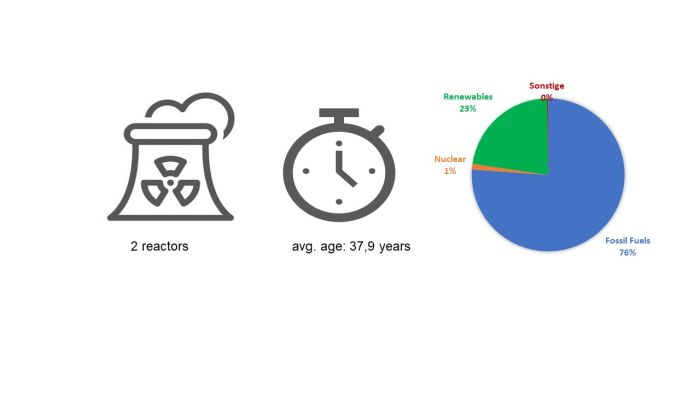
Only two reactors are operated in Africa, producing around 1% of the total electricity mix. They are both located in South Africa, where nuclear energy accounts for 6% of the electricity mix. Both plants were built at the same time and connected to the grid in 1984 and 1985, respectively, resulting in an average age of 37.9 years. There are currently no plans for other construction projects in South Africa.
However, since the power grids on the continent will have to be expanded in the coming years, nuclear energy could play a greater role here in the future. This also makes the continent interesting for foreign investors. Some countries (e.g. Ghana, Kenya, Uganda) are concretely dealing with how to realise an entry into nuclear energy.
In Egypt, it is planned to build four Russian reactor units (VVER-1200) at the El Dabaa site. The construction licence for the first two units was granted in 2022.
